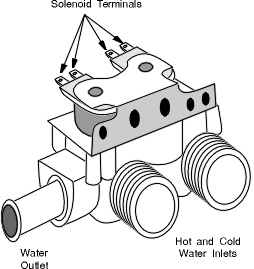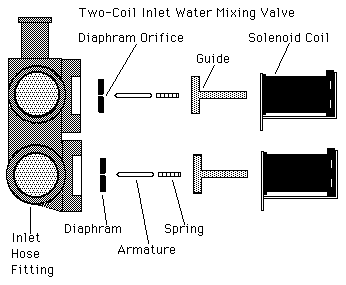 Washer water control problems just gotsta be in the top five most frequent appliance complaints I get. The complaint is either:
Washer water control problems just gotsta be in the top five most frequent appliance complaints I get. The complaint is either:
- very slow water flow into the washer (usually on the cold water only), or
- water keeps trickling in even with the washer unplugged.
Thang about it is that the solution is just so gawd-awful simple to fix that I’m reluctant to give away the secret to this great cash cow. Yeah, I know, I shouldn’t reveal this treasured trade secret that all appliance repair techs swear an oath to defend. What? You say you want me to tell you anydamnway? Well…ok then.
Most of the time, your water flow complaints will be about either the cold or the hot water being restricted to near nothing. Sometimes, both the hot and cold water flow are restricted and the water just trickles in no matter where you got the temp control set at. Either way, 90% of the time, the problem is because of sediment built up on the inlet screen of the washer inlet valve. Almost always, the cold water flow is most affected by sediment because your water heater acts as a settling basin and removes most of the sediment. (This also means that sediment is accumulating inside your water heater and its tank is rotting out even as you read this.)
 Here’s a typical two-solenoid inlet valve. This is the most common, although some Whirlpools use a three solenoid arrangement and front loaders get even more funky, but the diagnosis and correction are the same. Most of the time, what happens is that sediment builds up on the inlet screen of the solenoid valve and restricts the water flow into the valve.
Here’s a typical two-solenoid inlet valve. This is the most common, although some Whirlpools use a three solenoid arrangement and front loaders get even more funky, but the diagnosis and correction are the same. Most of the time, what happens is that sediment builds up on the inlet screen of the solenoid valve and restricts the water flow into the valve.
Now, here’s where you can benefit from my lifetime experience as a certifiable appliance guru. There’s something I call the stupid plumber’s trick where the unsuspecting appliance owner calls in one o’ them real hairy, stinky plumbers to fix their washer. Well, Buttcrack Bubba correctly takes a look at the inlet valve and figgers he’s being reeeel clever by just removing the inlet screen altogether. Most of the time, Buttcrack Bubba does this ’cause he ain’t even got a washer valve on his truck so it’s the difference between making something off the job ’cause he "fixed" it, or making next to nothing ’cause he didn’t have the part and he’d have to come back to do the repair. Buttcrack Bubba’s in, what we in the trade call, "the horns of an enema." Yessir, so he goes ahead and removes that screen. The customer don’t know any better; heck, all he knows is that water’s flowing to his washer again. It’s a freakin’ miracle!
 What happens next, though, is a sad tale to tell. Y’see, after a while, the innards of the valve get so gunked up with sediment that the valve can no longer stop the flow of water when it’s supposed to (like, when the washer is unplugged). You can see here that they’s a whole buncha delicate leetle bitty parts in there, da, comrade? Little, itty-bitty pieces of dirt and pipe scale can stick that plunger guide wide-ace open. So, water just keeps on flowing into the washer. Meanwhile, you’re outside playing frisbee with the dog, knockin’ back a fohty of Old Milwaukee and the gottdayam washer overfills making one helluva mess in your house. All cause o’ that stupid plumber’s trick. Now, how smart was that to call in a plumber to do an appliance tech’s job?
What happens next, though, is a sad tale to tell. Y’see, after a while, the innards of the valve get so gunked up with sediment that the valve can no longer stop the flow of water when it’s supposed to (like, when the washer is unplugged). You can see here that they’s a whole buncha delicate leetle bitty parts in there, da, comrade? Little, itty-bitty pieces of dirt and pipe scale can stick that plunger guide wide-ace open. So, water just keeps on flowing into the washer. Meanwhile, you’re outside playing frisbee with the dog, knockin’ back a fohty of Old Milwaukee and the gottdayam washer overfills making one helluva mess in your house. All cause o’ that stupid plumber’s trick. Now, how smart was that to call in a plumber to do an appliance tech’s job?
Other times, problems with no water can be the pressure switch or a burned-out solenoid in the water valve. If there ain’t much sediment on the inlet screen of the water valve, you gotsta measure the continuity of the solenoid coil at the terminals. If your meter says there’s no ohms in the solenoid coil, that sucker is slap-open and it’s gotta be replaced. That’s the name o’ that tune, Hoss.
If solenoid continuity is OK, then you may need to measure the voltage at the solenoid coil. This is a live test, meaning the circuit will have 120v on it, so you can get your big ol’ gluteus flabbeous shocked off if’n you ain’t careful, Slick. If you ain’t getting 120v to the valve during the fill portion of the cycle, then you need to check the pressure switch, or fill switch. This diagram shows how the pressure switch (fill switch) talks to the water inlet valve.
Well alright then. That’s about all the rocket science involved with this little gig. All that’s left for you to do is order a new water fill valve. While you’re at it, how ’bout upgrading those cheesy black rubber fill hoses to burst-proof stainless steel-braided fill hoses. Hey, Slick, it’s the cheapest flood insurance you’ll ever buy. Since we’re talkin’ about washer floods, come read more about how to prevent ’em ratcheer.
And, of course, your loving donations to the United Samurai Beer Fund would be received most joyously.
To learn more about your washer or to order parts,
click here.


